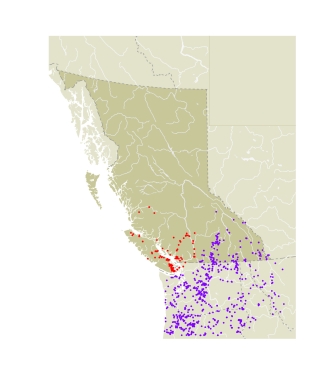AdultLorquin's Admirals are large black butterflies with a broad white band across the middle of the wings. The forewings have orange red tips on both the dorsal and ventral surfaces. The white bands crossing the wings are broken into distinct spots by wide black veins. Females are larger and have more well developed markings than males. Hybrids between Lorquin's Admirals and White Admirals have a mixture of the characters of the two species.
Immature StagesEggs are thimble-shaped, with deep hexagonal pitted cells; the edges or "corners" where the cells meet are drawn out into short, fine glassy hairs. They are pale green and the surfaces of the pits have a shiny, glassy effect (GAH). First instar larvae have a very large dark brown head and an olive green body with two pairs of dark tubercles on the thorax and two pairs on the abdomen (GAH). In mature larvae from Vernon, the head is pale lilac to pale mauve tan, and is bilobed with one pair of modified scoli on top of each lobe. The body is dark brown purple to grey mauve, with the back mostly white, washed with pale mauve. There is a mauve white line on each side of the abdomen (Sugden 1970). Pupae have a large keel projecting from the back of the thorax. The wings and the back of the abdomen are dark olive grey; the thorax is dull purplish and mottled with white. The rest of the abdomen is dirty white, shaded with grey and black on the sides and in a broad double ventral band (Dyar 1891).
SubspeciesThe subspecies name burrisonii Maynard, 1891 (TL: here restricted to the vicinity of Landsdowne, BC) has previously been applied to Limenitis lorquini in BC, Washington, and Oregon. The settlement of Landsdowne existed from 1889 to at least 1892 where Armstrong is now located, with the Armstrong family being among the first settlers (Williams 1889, 1892). L. lorquini and L. arthemis are found in the area, and hybrids between the species frequently occur. L.l. burrisonii was named by Maynard (1891), with a reasonably detailed description. He then stated that "there is considerable variation from the type towards typical lorquini …" This demonstrates that the description was of a single specimen, which is the holotype. L. lorquini adults in the vicinity of the type locality never have the combination of characters given in the original description, but lorquini x arthemis hybrids are always very similar to that description. The holotype, as originally described, is phenotypically intermediate between interior BC L. lorquini and L. arthemis, and was a hybrid. This is consistent with the conclusion of Layberry et al. (1998). The name burrisonii is therefore unavailable but enters into homonymy (ICZN Article 23.8) and is not available for reuse.
The name maynardi Field, 1936 (TL: Vancouver, BC), which might have applied to the southwestern BC populations, was proposed as a "transitional form" of L.l. burrisonii (Field 1936). As a form name, maynardi is unavailable for use as a subspecies name, contrary to Perkins and Perkins (1966). As a result there are no valid subspecies names to apply to the L. lorquini populations in BC; names and descriptions for two subspecies are provided here.
Limenitis lorquini itelkae Guppy, new subspecies. Limenitis lorquini itelkae has smaller orange red forewing tips, the wing tips are a darker red, and the white band on the upperside of the wings is narrower than in the nominate subspecies. It has a paler ventral wing surface and larger white markings, and more of them, than subspecies ilgae (below). The red brown ground colour of the hindwing underside is lighter than in subspecies ilgae, and there is a cluster of white markings in the basal area of the hindwing in subspecies itelkae that is missing from subspecies ilgae. Types. Holotype: male, BC, Keremeos, 1 mile N of Hwy 3A on Mt. Apex Rd., 8 June 1982, C.S. Guppy; a label "HOLOTYPE / Limenitis lorquini / itelkae Guppy" is attached. The holotype is deposited in the Royal British Columbia Museum, Victoria, BC, CAN. Paratypes: 8 males, 1 female, BC, 8 km. E Cawston, 1 July 1978, J. and S. Shepard (JHS); 1 female, BC, Kilpoola L., 1 July 1996, J. and S. Shepard (JHS); Osoyoos, Anarchist Mountain, 1 June 1975, C.S. Guppy (CSG).
Limenitis lorquini ilgae Guppy, new subspecies. In Limenitis lorquini ilgae, the upperside of the wings is similar to that of subspecies itelkae, except for somewhat wider black veining separating the white spots composing the white band across the wings. The extent and variability of the orange red forewing tips is similar for the two subspecies. In subspecies ilgae, the ventral hindwing surface is a darker, richer red brown ground colour compared with subspecies itelkae, and there are no white markings at the base of the ventral hindwing. Types. Holotype: male, BC, Bamberton,Jones Creek Road to Oliphant Lake, 9 July 1988, C.S. Guppy; a label reading "HOLOTYPE / Limenitis lorquini / ilgae Guppy" is attached. The holotype is deposited in the Royal British Columbia Museum, Victoria, BC, CAN. Paratypes: 6 males, 1 female, same data as holotype (CSG); 1 male, BC, Bamberton, 0.5 km south of cement plant, 23 June 1989, C.S. Guppy (CSG); 1 male, BC, Duncan, Mt. Prevost summit, 12 July 1987, C.S. Guppy (CSG); 2 males, 1 female, BC, Malahat, 17-Mile Road, 1 July 1987, C.S. Guppy (CSG); 1 female, BC, Mt. Benson, headwaters of Wolf Creek, 24 June 1989, C.S. Guppy (CSG); 2 males, BC, Mt. Brenton Road, 16 July 1995, J. and S. Shepard (JHS); 2 males, BC, Uplands Park, Vanc. Isl., 2 June 1995, Jon H. Shepard (JHS); 1 female, BC, powerline at Shawnigan L. - Mill Bay Road, 24 May 1995, Jon H. Shepard (JHS); 1 male, BC, Fitzgerald, 26 June 1995, C.S. Guppy (JHS).
